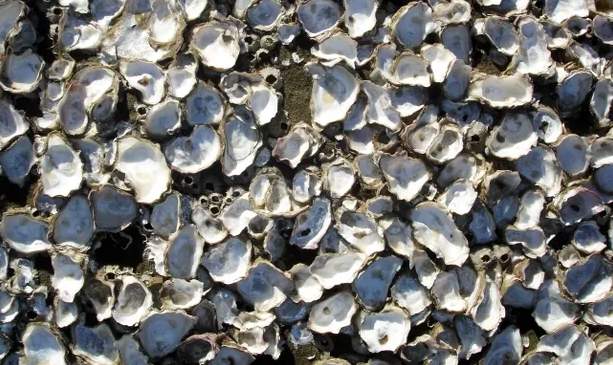
Marine scientists are lobbying the federal government to ensure protection for Australia’s most endangered – but least known – ocean ecosystem.
Shellfish reefs, formed by millions of oysters or mussels clustering together in or near the mouths of estuaries, have declined by up 99% since British colonisation. Yet they are not formally recognised as a threatened ecosystem under Australian environmental law.
A study led by the Nature Conservancy Australia and published in the peer-reviewed open access journal Plos One on Thursday found that the number of reefs formed by Australian flat oysters, Ostrea angasi, had declined 99% from 118 found in historical records to just one, in Tasmania’s Georges Bay.
The number of reefs formed by rock oysters, Saccostrea glomerata, which are found on coastal banks around Sydney, declined 90% from 60 known historical locations to six surviving reefs.
It is even more drastic than the decline in the Great Barrier Reef, which suffered unprecedented mass bleaching events in 2016 and 2017 that are believed to have killed up to half of the coral, and the shrinking of kelp forests, which have declined 90% off the coast of Western Australia due to successive marine heatwaves.
“While it and other coral reefs are indeed under threat, it’s the shellfish reefs that have really suffered the most,” James Cook University senior researcher Ian McLeod, a co-author on the study, said. “It’s just that most of them disappeared before we were born so people aren’t aware we’ve lost them,”
Chris Gillies, marine manager at the Nature Conservancy Australia and lead author on the study, said researchers would use the data from the latest study to apply this month for shellfish reefs to be included on the threatened ecosystem list under the Environment Protection and Biodiversity Conservation Act 1999.
“As a species they are not going to be wiped off the map, but as an ecosystem there is not many of them left,” he said. “It’s like river red gums. There are always going to be river red gums but river red gum forests – there’s very few of them left.”
Gillies said that he hoped the proximity of shellfish reefs, which have historically been found in high population areas such as Sydney harbour and Melbourne’s Port Phillip Bay, would help drive community support.
Restoration projects, involving dropping rocks into the previous reef sites and seeding those rocks with oyster larvae, have already been funded along Australia’s southern coast.
“It’s something that’s right under the nose of most coastal Australians,” Gillies said. “These reefs are restorable with funding. We can bring back the reef sand, all the benefits that come with that as well.”
The benefits are in water filtration, increased local fish production, and bank stabilisation.
A one-hectare oyster reef can filter 2.7bn litres of sea water per year, removing 142kg of nitrogen and 22kg of phosphate. That is about 100L of water per oyster per day.
Those toxins are converted into pellets, which provide a rich food source and allow the reef to sustain 375kg of new fish per hectare per year.
Researchers examined fishing records and Indigenous middens to determine the locations of historic shellfish reefs, which were harvested and polluted to extinction by white settlers in the late 18th and early 19th century.
Much of the information came from newspaper clippings, often from people writing in to complain that the oyster bank they harvested had declined.
Mention of natural oyster reefs dropped away by the 1950s. Farms using pacific oysters (Crassostrea gigas), a Japanese native, soon took over the food supply.
“People essentially forgot about native oyster reefs because they stopped farming from them, and they left them behind in the fishing records,” Gillies said.
